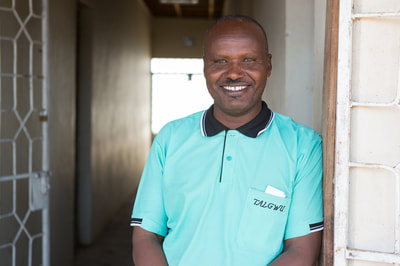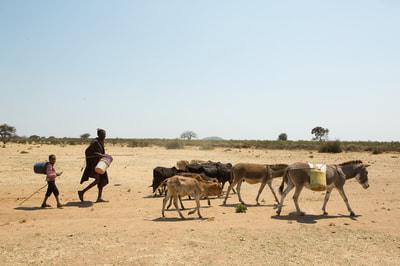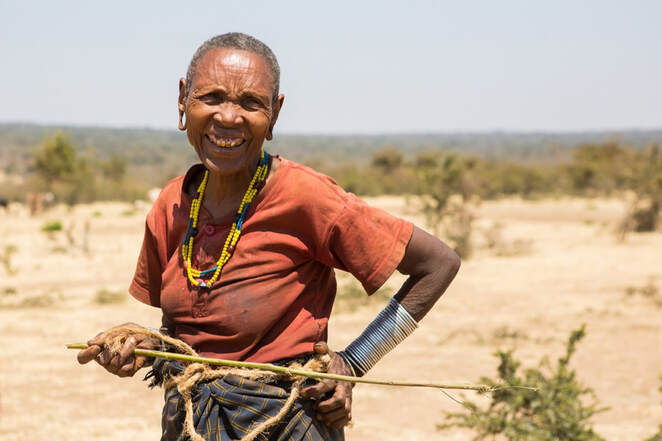Demarcating Dirma: When Everyone Benefits
As the Ward Officer for Dirma in Hanang District, Daudi attests the impact of Land Use Planning on his local community. An avid supporter of UCRT and their work in his ward, Daudi credits the recent conflict resolution in Dirma to UCRT’s support in land use planning.
“Before UCRT came to Dirma there were many issues with land use for farming and livestock grazing. There was conflict amongst the villages here, but UCRT has solved this problem,” he said.
Increasing population in the area has compounded ongoing land use issues. A lack of designated or agreed areas or systems for cattle grazing and farming caused conflict within the community as farms were trampled by grazing livestock, and grazing areas became encroached by plantations. UCRT worked with Daudi and his community leadership, farmers, and pastoralists to achieve land demarcation of by-law protected farming and grazing areas. With all community members agreeing to land borders and grazing schedules now everyone in the district has the opportunity to provide for their families.
“The conflict is now over for these people. Everyone can live in peace and feel secure about their right to graze their livestock or farm their produce.”
Having seen UCRT’s success in resolving this matter, in 2015 Daudi again turned to UCRT for help in resolving a new area of conflict in his ward.
"A new village has been established in Gawlolo which is causing problems with the existing people in the area. To avoid conflict we need to demarcate the land between villages in the area and give them their own certificates of occupancy. UCRT has begun to help us with this, and will continue to work with us in 2016."
“Before UCRT came to Dirma there were many issues with land use for farming and livestock grazing. There was conflict amongst the villages here, but UCRT has solved this problem,” he said.
Increasing population in the area has compounded ongoing land use issues. A lack of designated or agreed areas or systems for cattle grazing and farming caused conflict within the community as farms were trampled by grazing livestock, and grazing areas became encroached by plantations. UCRT worked with Daudi and his community leadership, farmers, and pastoralists to achieve land demarcation of by-law protected farming and grazing areas. With all community members agreeing to land borders and grazing schedules now everyone in the district has the opportunity to provide for their families.
“The conflict is now over for these people. Everyone can live in peace and feel secure about their right to graze their livestock or farm their produce.”
Having seen UCRT’s success in resolving this matter, in 2015 Daudi again turned to UCRT for help in resolving a new area of conflict in his ward.
"A new village has been established in Gawlolo which is causing problems with the existing people in the area. To avoid conflict we need to demarcate the land between villages in the area and give them their own certificates of occupancy. UCRT has begun to help us with this, and will continue to work with us in 2016."
|
Gidiyanju Gidamarirda Samuhenda
At 65, Gidiyanju’s pastoralist knowledge is more innate than considered. He has grazed livestock for his father, himself, and his children and grandchildren for more than 50 years. Gidiyanju is from Basantu village, in a neighbouring ward of Dirma. He makes the long walk to this particular grazing area with his youngest livestock because he knows the pasture is safe and healthy thanks to by-law’s the village developed with UCRT’s support since 2014. UCRT has protected this area from development and ensured grazing space for pastoralists. I come here from afar because I know my young livestock can develop here, with the healthy land and pasture. This land is safe because of the by-laws UCRT helped put in place. I am welcome here with my cattle, and can secure the financial welfare of my family without conflict. It is a long walk. But it is worth it.” |
Udangaida’s feet wear the red dust of 30 years of cattle grazing. A stoic woman of the Datoga tribe in northern Tanzania, Udangaida is second wife to a Datoga tribesman, mother of four grown children and caretaker of the family’s livestock. Today, she grazes her cattle freely but this hasn’t always been the case.
“My family depends on our livestock, and our livestock depends on grazing land. This has been the source of conflict for Datoga people for many generations.”
Udangaida tells her story from a designated grazing area in the Dirma ward of Hanang District. She has been grazing her cattle in this particular field for more than 20 years, but only since 2014 has she done so without risk of conflict or expulsion. Udangaida thanks the work of UCRT for her improved security.
“The land use planning by UCRT in this district has made my life easier. I always used this area for grazing, but too many people grazing here and disputes with farmers meant the land wasn’t always plentiful enough to keep my cattle healthy. Since the by-laws came into effect, my livestock numbers have increased, and my milk production too. This is because the land use plans have given pastoralists enough space to graze, and also gives the land time to regenerate.”
Three hundred metres east of Udangaida and her cattle, the border between the designated grazing area and the neighbouring farming area is made clear by a neat line of dense crops that spring from the dusty field. The efficient and compact use of the farming area highlights the shared dependency of this land area by many different people. It is easy to see how conflicts occurred in the past.
The demarcation and land use planning work in this area has achieved peaceful and productive cohabitation for pastoralist and farming Datoga people, and for this Udangaida is grateful.
“Our dependency on the land is now guaranteed, without needing conflict with our neighbours. Now we can all share the land and just focus on providing for our families.”
“My family depends on our livestock, and our livestock depends on grazing land. This has been the source of conflict for Datoga people for many generations.”
Udangaida tells her story from a designated grazing area in the Dirma ward of Hanang District. She has been grazing her cattle in this particular field for more than 20 years, but only since 2014 has she done so without risk of conflict or expulsion. Udangaida thanks the work of UCRT for her improved security.
“The land use planning by UCRT in this district has made my life easier. I always used this area for grazing, but too many people grazing here and disputes with farmers meant the land wasn’t always plentiful enough to keep my cattle healthy. Since the by-laws came into effect, my livestock numbers have increased, and my milk production too. This is because the land use plans have given pastoralists enough space to graze, and also gives the land time to regenerate.”
Three hundred metres east of Udangaida and her cattle, the border between the designated grazing area and the neighbouring farming area is made clear by a neat line of dense crops that spring from the dusty field. The efficient and compact use of the farming area highlights the shared dependency of this land area by many different people. It is easy to see how conflicts occurred in the past.
The demarcation and land use planning work in this area has achieved peaceful and productive cohabitation for pastoralist and farming Datoga people, and for this Udangaida is grateful.
“Our dependency on the land is now guaranteed, without needing conflict with our neighbours. Now we can all share the land and just focus on providing for our families.”
Copyright 2020 Ujamaa Community Resource Team - All Rights Reserved




